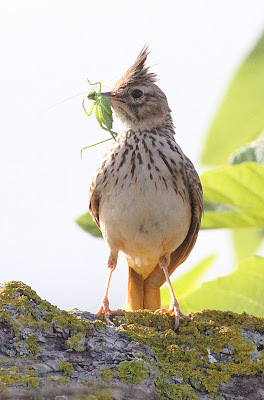Another cool, cloudy start saw me at Fluke Hall earlier than most, with just one car in the doggy walkers starting grid. The brambly hedgerow there just behind the sea wall is the best place to find the first Whitethroat, this morning’s bird obliging with a blast of scratchy song the moment the car door opened.
Whitethroat
I set off towards Ridge Farm, and then negotiated the Pilling Puzzle, hoping for other bits and bobs along the way which heads back to the sea wall. I kept a wary eye on the menacing sky which threatened an April shower or two as I logged 4 singing Skylark, 5 Swallows dashing east, a couple of Linnets and a field with 40+ Woodpigeon and 2 Stock Dove. A Collared Dove obliged by staying on the gate post, but this was to be my best photo opportunity of the morning, hence the filler landscapes and peas on a drum later in the post.
Collared Dove
Pilling Puzzle
Pilling Sky
Back in Fluke Hall wood I logged my first Blackcap of the year, singing as tiny Blackcaps do at a volume sufficient to be heard many, many metres away. Also here in the shelter of the woodland, 2 Willow Warblers and a Chiffchaff.
Along Backsands Lane a roadside Kestrel carrying prey appeared to be hurrying towards Damside where a pair nest most years, and as I stopped to watch the Kestrel I noted a pair of Redshanks together in the wet field.
At the car park I broke off birding to admire an old motor vehicle. In some ways out-in-the-sticks Pilling is a tad out of date, stuck in its ways even, but not when it comes to money. The owner of this Austin Seven pick-up offered to sell me the vehicle for £10,000. I told him I could buy a good Canon lens with ten grand, but he just gave me an old fashioned look.
Pilling Transport
It was a great morning to be out, even if I wasn’t seeing many birds along the way to Pilling Water: 1 Grey Heron, 1 Little Egret, 2 Tufted Duck, 2 Little Grebe, 2 Meadow Pipit and 8 Skylark. At Pilling Water I stopped to count the geese as there looked more than of late and came up with 600+ Pink-footed Goose and 1 Brent Goose. Looks like there’s been an influx of geese from Norfolk where the majority of the wintering Brent Geese belong to the Dark-bellied form bernicla. The geese were distant, more so when a jogger came along the sea wall behind me to spook them further away.
Brent Goose with Pink-footed Goose
Not much else along here, 2 Teal and a Shoveler on the wildfowler’s pools, more Skylarks and a flock of 45 Golden Plover, attacked at one point by a Peregrine which flew off when at first it didn’t succeed.
Golden Plover and Lapwing
Back at the car park I took the picture below. I am a dog lover, grew up with dogs and have the scars to prove it. Nowadays some dog owners are extremely selfish and inconsiderate to the extent that the latest fashion is to discard bags of dog shit in public places where they expect volunteers or poorly paid public servants to pick it up instead of the owners taking it back home where it belongs. I’ll bet they were visitors to a local caravan park or incomers – Pilling People simply don’t do that.
Litter Louts
































.JPG)




.JPG)







.jpg)











